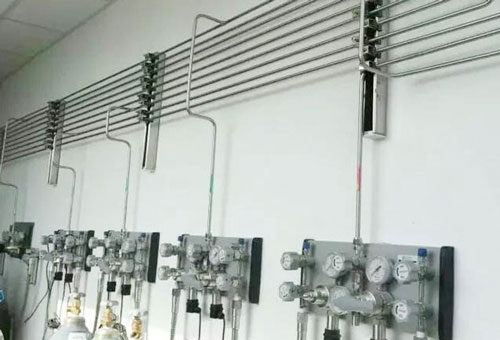High purity gas pipeline piping
All high-purity and high-purity gases need to be transported through pipelines to the point of use (POU) of the equipment. In order to meet the quality requirements of the process for gases, it is even more important to pay attention to the material selection and construction quality of the piping system, provided that the gas outlet indicators are certain. In addition to depending on the accuracy of gas production or purification equipment, it is largely influenced by various factors in the pipeline system. Therefore, the selection of pipe materials should adhere to relevant industry principles and indicate the pipe material in the drawings.
The material of the pipeline is selected according to the needs of use. If it is a reaction gas used in the process, high-grade 316L EP pipes are selected. After electrolytic polishing treatment, they are corrosion-resistant and have low surface roughness. The Rmax (maximum peak to valleyheight) is about 0.3 μ m or less, which is much lower than the 0.8 μ m of 316L BA pipes treated with Bright Anneal. The higher the flatness, the less likely it is to form micro eddies and carry out pollutant particles. 316L BA tubes are commonly used for gases that come into contact with chips but do not participate in process reactions, such as GN2 and CDA. For more gas knowledge, please follow the WeChat account of Gas Circle: Gasgroup Tube Inner Surface Roughness is the standard for measuring the quality of pipes. The lower the roughness, the lower the possibility of particle carrying. Another type of AP pipe that has not been specially treated (Annealing&Picking) is used as a double outer pipe that is not used as a gas supply pipeline.
At present, there are relatively few reference standards for clean pipelines in China. Usually, in addition to referring to relevant technical industry specifications such as the "Code for Design of Cleanrooms", "Code for Design of Hydrogen Stations", "Code for Design of Hydrogen and Oxygen Stations", "Code for Design of Compressed Air", etc., our commonly used material selection and piping in the industry generally refer to internationally recognized industry standards:
Requirements for various gas piping fittings
In the semiconductor industry, as the line width becomes smaller, the requirements for gas purity, particle size, impurity content, and dew point are also increasing.
High purity nitrogen (PN2): The system pipeline adopts inner wall electrolytic polishing (EP) low-carbon (316L) stainless steel pipes, and the valves use corrugated pipe valves or diaphragm valves of the same material.
Nitrogen (N2): The system pipeline adopts inner wall electrolytic polished (EP) low-carbon (316L) stainless steel pipes or bright annealed (BA) low-carbon (316L) stainless steel pipes, and the valves use corrugated pipe valves or ball valves of the same material.
High purity hydrogen (PH2) hydrogen (H2): The system pipeline adopts inner wall electrolytic polishing (EP) low-carbon (316L) stainless steel pipes, and the valves use corrugated pipe valves or diaphragm valves of the same material. Argon (Ar): The system pipeline adopts inner wall electrolytic polished (EP) low-carbon (316L) stainless steel pipes, and the valves use corrugated pipe valves or diaphragm valves of the same material.
Helium (He): The system pipeline adopts inner wall electrolytic polishing (EP) low-carbon (316L stainless steel pipe), and the valve adopts corrugated pipe valve or diaphragm valve of the same material.
Special gas system: If necessary, double casing is also required: the outer pipe is treated with acid pickling and passivation (AP), the inner pipe is electro polished (EP), and the valves are made of corrugated pipe valves or diaphragm valves of the same material.
Compressed Air (CDA): The system pipeline uses bright annealed (BA) low-carbon (316L) stainless steel pipes, and the valves use ball valves of the same material (copper pipes can also be used by companies with low requirements, depending on process requirements)
For special gases, there are many types of gases and many toxic and harmful gases. Originally, one machine was equipped with one gas cabinet, and the high equipment combination and maintenance costs greatly increased the investment cost. Some of them were also arranged in the process room, which posed a safety hazard of leakage. Nowadays, centralized gas supply systems are widely used, with centralized gas cabinets and continuously improved self-control systems. Their alarm, spraying, switching, and blowing are more mature. The special gas room is also isolated from the process room and has explosion-proof requirements for the room, greatly improving the safety of work.
For corrosive, toxic, and flammable gases, it is usually designed to place the steel cylinder in a Gas Cabinet, and then supply the gas to the Valve Manifold Box (VMB) near the site through pipelines, and then enter the Point of Use (POU) of the process machine. For more gas knowledge, please follow the Gas Circle WeChat: Before entering the machine cavity, the gas group will have an independent Gas Control Panel (GB) connected to the process control module to control the flow rate and the mixing ratio of the intake through a Mass Flow Controller (MFC). Usually, this gas control panel does not belong to the design scope of the factory system, but belongs to the process machine. Part of the equipment. Generally, inert gases are supplied through open gas rack and valve manifold panel (VMP).
Requirements for different gas piping systems
When dealing with gases with strong corrosive properties, corrosion-resistant stainless steel pipes should be used for piping. Otherwise, corrosion spots will appear on the inner surface of the pipes due to corrosion, and in severe cases, large areas of metal will peel off or even puncture, thereby polluting the pure gas transmission and distribution.
The connection of high-purity and high-purity gas transmission and distribution pipelines with high flow rates should generally be welded, and the required pipe materials should not change in structure during welding. When welding materials with high carbon content, the permeability of the welding area causes mutual permeation of gases inside and outside the pipe, which destroys the purity, dryness, and cleanliness of the transported gas, rendering all our efforts meaningless.
In summary, for high-purity gas and specialty gas transmission pipelines, a specially treated high-purity stainless steel pipe is required to ensure that the high-purity pipeline system (including pipes, fittings, valves, VMBs, VMPs) plays a crucial role in high-purity gas distribution





